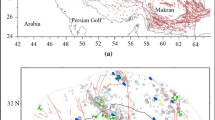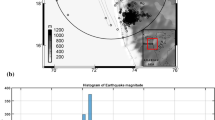Abstract
This study presents hazard estimation of Kashmir Basin, NW Himalaya using regional ground motion relations, representing one of the most seismically active region in the Himalayan belt. Fault-level seismic recurrence parameters are determined from an updated earthquake catalogue spanning from 25 to 2018 AD for all possible seismic sources. The estimated hazard maps are presented for three ground motion parameters (PGA, short and long period spectral acceleration) for 50, 100, 500 and 2500 years return periods. Moreover, uniform hazard response spectrums and hazard curves are presented for all ten districts of the basin. The southern section of the basin consisting districts of Budgam, Shopian, Pulwama and Kulgam show higher hazard levels due to presence of numerous seismogenic structures in close vicinity. Our results highlight that the imposed seismic hazard in Kashmir basin is highly underestimated which need to be redressed by modifying the current provisional design standards.















Similar content being viewed by others
References
Abrahamson NA, Litehiser JJ (1989) Attenuation of vertical peak acceleration. Bull Seismol Soc Am 79(3):549–580
Ahmad B, Shafi M (2014) Some more earthquakes from medieval Kashmir. J Seismol 18(3):681–686
Ahmad B, Bhat MI, Bali BS (2009) Historical record of earthquakes in the Kashmir Valley. Himal Geol 30:75–84
Ahmad B, Sana H, Alam A (2014) Macroseismic intensity assessment of 1885 Baramulla Earthquake of north-western Kashmir Himalaya, using the Environmental Seismic Intensity scale (ESI 2007). Quat Int 321:59–64
Ahmad S, Alam A, Ahmad B, Bhat MI, Bhat MS (2015) Geomorphic evidence of unrecognized Balapur fault segment in the southwest Kashmir basin of northwest Himalayas. Geomorphology 250:159–172
Algermissen ST, Perkins DM (1976) A probabilistic estimate of maximum acceleration in rock in the contiguous United States. US Geological Survey, Reston, VA, pp 76–416
Ambraseys NN (2000) Reappraisal of North-Indian earthquakes at the turn of the 20th century. Curr Sci 79:101–114
Ambraseys NN, Douglas J (2004) Magnitude calibration of north Indian earthquakes. Geophys J Int 159(1):165–206
Ambraseys N, Jackson D (2003) A note on the early earthquakes in northern India and southern Tibet. Curr Sci 84(4):570–582
Bhatia SC, Kumar RM, Gupta HK (1999) A probabilistic seismic hazard map of India and adjoining regions. Ann Geophys 42(6):1153–1164. 104401/ag-3777
Bilham R (2004) Earthquakes in India and the Himalaya: tectonics geodesy and history. Ann Geophys 47:839–858
Bilham R (2019) Himalayan earthquakes: a review of historical seismicity and early 21st century slip potential. In: Treloar PJ, Searle MP (eds) Himalayan tectonics: a modern synthesis, vol 483. Geological Society London Special Publications, London, pp 423–482
Bilham R, Bali BS (2013) A ninth century earthquake-induced landslide and flood in the Kashmir Valley and earthquake damage to Kashmir’s Medieval temples. Bull Earthq Eng 12:79–109
Bilham R, Wallace K (2005) Future Mw > 8 earthquakes in the Himalaya: implications from the 26 Dec 2004 Mw = 90 earthquake on India’s eastern plate margin. Geol Surv India Spec Publ 85:1–14
Bilham R, Gaur VK, Molnar P (2001) Himalayan seismic hazard. Science 293:1442–1444
BIS, I. 1893 (2002, 2007) Criteria for earthquake resistant design of structures
Boore DM (2009) Comparing stochastic point-source and finite-source ground-motion simulations: SMSIM and EXSIM. Bull Seismol Soc Am 99(6):3202–3216
Bukhari SK, Maqbool Y, Dar AM (2018) A study of seismic resilience and construction techniques of Srinagar city Jammu and Kashmir India. Disast Adv 11(10):26–36
Cárdenas M, Chávez-Garcia FJ (2003) Regional path effects on seismic wave propagation in central Mexico. Bull Seismol Soc Am 93:973–985
CENSUS (2001, 2011) Ministry of Home Affairs, Government of India
Cornell CA (1968) Engineering seismic risk analysis. Bull Seismol Soc Am 58(5):1583–1606
Dasgupta S, Pande P, Ganguly D, Iqbal Z, Sanyal K, Venkatraman NV, Dasgupta S, Sural B, Harendranath L, Mazumdar S (2000) Seismotectonic atlas of India and its environs. Geol Surv of India Spec Publ 59:1–43
DeMets C, Gordon R, Argus DF, Stein S (1994) Effect of recent revisions to the geomagnetic reversal time scale on estimates of current plate motions. Geophys Res Lett 21:2191–2194
Der Kiureghian A, Ang AHS (1977) A fault-rupture model for seismic risk analysis. Bull Seismol Soc Am 67(4):1173–1194
Dunbar PK, Bilham R, Laituri MJ (2003) Earthquake loss estimation for India based on macroeconomic indicators CIRUS (Editor) Risk science and sustainability. Cooperative Institute for research in environment science. Boulder https://doi.org/10.1007/978-94-010-0167-0_13
Gardner JK, Knopoff L (1974) Is the sequence of earthquakes in southern California with aftershocks removed Poissonian? Bull Seismol Soc Am 64(5):1363–1367
GSI (2000) Seismotectonic atlas of India and its environs geological survey of India, Bangalore, India
International Code Council (ICC) (2009) International building code IBC 2009
Iyengar RN, Ghosh S (2004) Microzonation of earthquake hazard in Greater Delhi area. Curr Sci India 87(9):1193–1202
Iyengar RN, Sharma D, Siddiqui JM (1999) Earthquake history of India in medieval times. Indian J Hist Sci 34:3
Joyner WB, Boore DM (1981) Peak horizontal acceleration and velocity from strong-motion records including records from the 1979 Imperial Valley, California, earthquake. Bull Seismol Soc Am 71(6):2011–2038
Khattri KN, Rogers AM, Perkins DM, Algermissen ST (1984) A seismic hazard map of India and adjacent areas. Tectonophysics 108(1–2):93–134. https://doi.org/10.1016/0040-1951(84)90156-2
Kijko A (2004) Estimation of the maximum earthquake magnitude Mmax. Pure Appl Geophys 161(8):1655–1681. https://doi.org/10.1007/s00024-004-2531-4
Kijko A, Graham G (1998) Parametric-historic procedure for probabilistic seismic hazard analysis: part I: estimation of maximum regional magnitude Mmax. Pure Appl Geophys 152(3):413–442
Knopoff L, Kagan Y (1977) Analysis of the theory of extremes as applied to earthquake problems. J Geophys Res 82(36):5647–5657
Kotha SR, Bindi D, Cotton F (2016) Partially non-ergodic region specific GMPE for Europe and Middle-East. Bull Earthq Eng 14(4):1245–1263
Kotha SR, Bindi D, Cotton F (2017) From ergodic to region-and site-specific probabilistic seismic hazard assessment: method development and application at European and Middle Eastern sites. Earthq Spectra 33(4):1433–1453
Kramer SL (1996) Geotechnical earthquake engineering. Pearson Education, London
Kundu B, Yadav RK, Bali BS, Chowdhury S, Gahalaut VK (2014) Oblique convergence and slip partitioning in the NW Himalaya: implications from GPS measurements. Tectonics 33(10):2013–2024
Madden C, Trench D, Meigs A, Ahmad S, Bhat MI, Yule JD (2010) Late quaternary shortening and earthquake chronology of an active fault in the Kashmir Basin. Northwest Himal Seismol Res Lett 81:346
Madden C, Ahmad S, Meigs A (2011) Geomorphic and paleoseismic evidence for late Quaternary deformation in the southwest Kashmir Valley, India. Out-of-sequence thrusting, or deformation above a structural ramp? AGU Abstracts, T54B-07
Mahajan AK, Thakur VC, Sharma ML, Chauhan M (2010) Probabilistic seismic hazard map of NW Himalaya and its adjoining area India. Nat Hazards 53(3):443–457
Mandal P, Rastogi BK, Gupta HK (2000) Recent Indian earthquakes. Curr Sci 79:1334–1346
McGuire RK (1976) FORTRAN computer program for seismic risk analysis. Open-file Report 76-67 US Geological Survey, Denver, USA
Motazedian D, Atkinson GM (2005) Stochastic finite-fault modeling based on a dynamic corner frequency. Bull Seismol Soc Am 95(3):995–1010
Muthuganeisan P, Raghukanth STG (2016) Site-specific probabilistic seismic hazard map of Himachal Pradesh India part II hazard estimation. Acta Geophys 64(4):853–884
Nath SK, Thingbaijam KK (2012) Probabilistic seismic hazard assessment of India. Seismol Res Lett 83(1):135–149
NDMA (2011) Development of probabilistic seismic hazard map of India. Technical Report of the Working Committee of Experts (WCE) National Disaster Management Authority (NDMA), Govt of India, New Delhi, India
Parvez IA, Vaccari F, Panza GF (2003) A deterministic seismic hazard map of India and adjacent areas. Geophys J Int 155(2):489–508
Peng KZ, Wu FT, Song L (1985) Attenuation characteristics of peak horizontal acceleration in northeast and southwest China. Earthq Eng Struct Dyn 13(3):337–350
Quittmeyer RC, Jacob KH (1979) Historical and modern seismicity of Pakistan, Afghanistan, northwestern India and southwestern Iran. Bull Seismol Soc Am 69(3):773–823
Raghukanth ST (2008) Ground motion estimation during the Kashmir earthquake of 8th October 2005. Nat Hazards 46(1):1–3
Schiffman C, Bali BS, Szeliga W, Bilham R (2013) Seismic slip deficit in the Kashmir Himalaya from GPS observations. Geophys Res Lett 40(21):5642–5645
Scordilis EM (2006) Empirical global relations converting MS and mb to moment magnitude. J Seismol 10(2):225–236
Shah AA (2014) Comment on: “Macroseismic intensity assessment of 1885 Baramulla Earthquake of northwestern Kashmir Himalaya, using the Environmental Seismic Intensity scale (ESI 2007)” by Ahmad et al. 2013. Quat Int. https://doi.org/10.1016/j.quaint.2014.04.064
Shah AA, Malik JN (2017) Four major unknown active faults identified, using satellite data, in India and Pakistan portions of NW Himalaya. Nat Hazards 88(3):1845–1865
Sing SK, Ordaz M (1993) On the origin of long coda observed in the lake-bed strong-motion records of Mexico City. Bull Seismol Soc Am 83:1298–1306
Stepp JC (1972) Analysis of completeness of the earthquake sample in the Puget sound area and its effect on statistical estimates of earthquake hazard. In: Proceedings 1st international conference on Microzonation, Seattle, USA, vol 2, pp 897–909
Stidham C, Antolik M, Dreger D, Larsen S, Romanovicz B (1999) Three-dimensional structure influence on the strong motion wavefield of the 1989 Loma Prieta earthquake. Bull Seismol Soc Am 89:1184–1202
Uhrhammer RA (1986) Characteristics of northern and central California seismicity. Earthq Notes 57(1):21
USNRC (1997) USNRC Regulatory Guide 1165: identification and characterization of seismic sources and determination of safe shutdown earthquake ground motion. Unites States Nuclear Regulatory Commission Washington DC USA
Wani AA, Bali BS, Lone S (2019) Drainage characteristics of tectonically active area: an example from Mawar Basin, Jammu and Kashmir, India. J Geol Soc India 93(3):313–320
Wells DL, Coppersmith KJ (1994) New empirical relationships among magnitude rupture length rupture width rupture area and surface displacement. Bull Seismol Soc Am 84(4):974–1002
Wyss M (2005) Human losses expected in Himalayan earthquakes. Nat Hazards 34:305–314
Yousuf M, Bukhari KS (2019) Impact of geological and environmental complexities over infrastructure development in Kashmir Himalaya. Disast Adv 12(4):29–40
Yousuf M, Bukhari SK (2020) Evaluation of seismically induced Soft Sediment deformation structures vis-a-vis their probable earthquake sources in Kashmir basin, NW Himalaya. J Earthq Tsunami. https://doi.org/10.1142/S1793431121500032
Yousuf M, Bukhari SK, Dar AM, Mir AA (2018) Seismic Vulnerability Assessment of major construction pattern of the of Srinagar city. Int J Recent Trends Sci Eng 7(4):1889–1901
Yousuf M, Bukhari SK, Bhat GR, Ali A (2020) Understanding and managing earthquake hazard visa viz disaster mitigation strategies in Kashmir valley, NW Himalaya. Prog Disast Sci 5:100064
Author information
Authors and Affiliations
Corresponding author
Ethics declarations
Conflict of interest
On behalf of all authors, the corresponding author states that there is no conflict of interest.
Rights and permissions
About this article
Cite this article
Yousuf, M., Bukhari, K. Hazard estimation of Kashmir Basin, NW Himalaya using probabilistic seismic hazard assessment. Acta Geophys. 68, 1295–1316 (2020). https://doi.org/10.1007/s11600-020-00485-2
Received:
Accepted:
Published:
Issue Date:
DOI: https://doi.org/10.1007/s11600-020-00485-2




